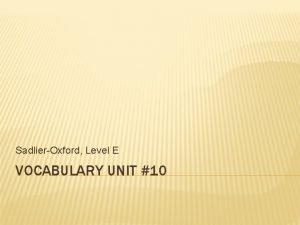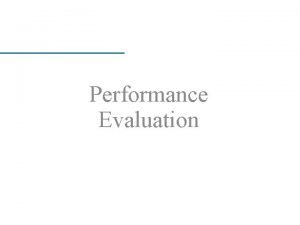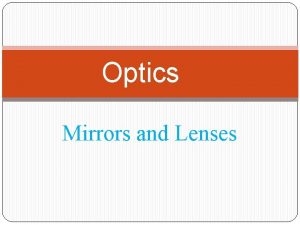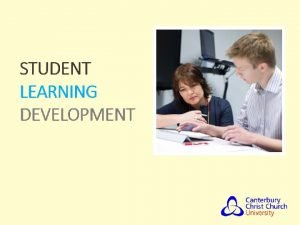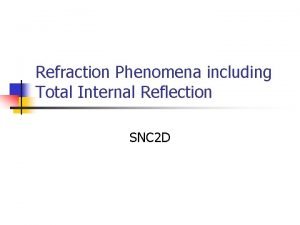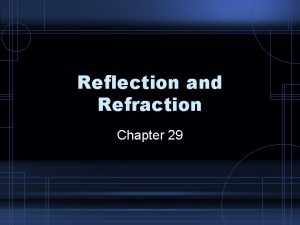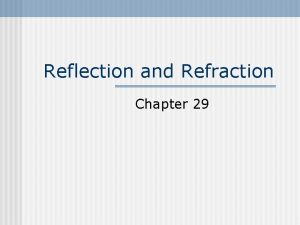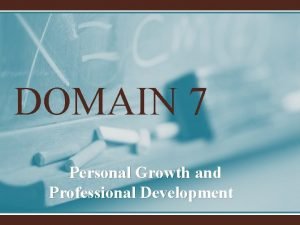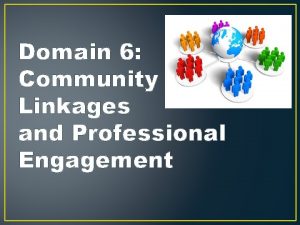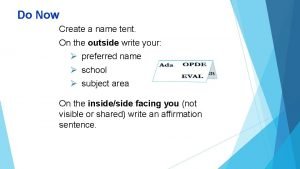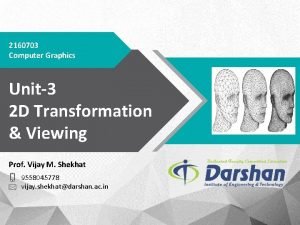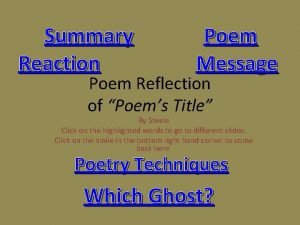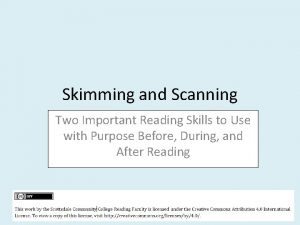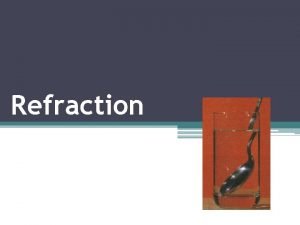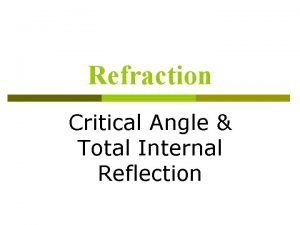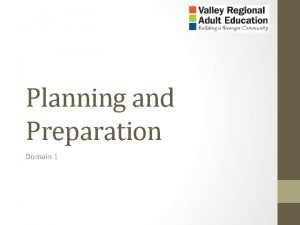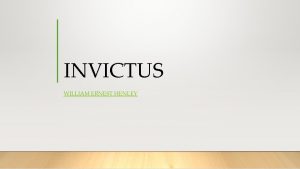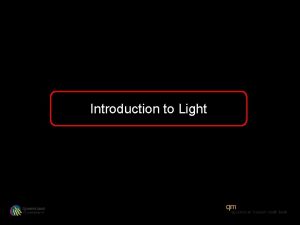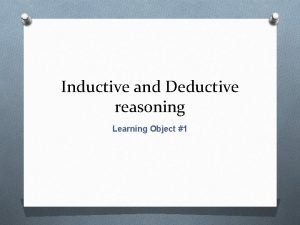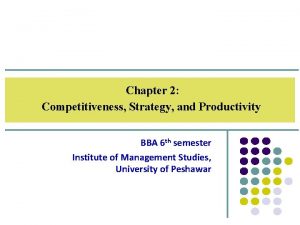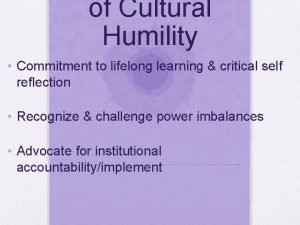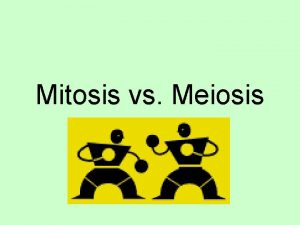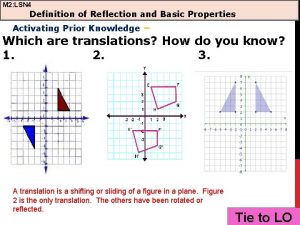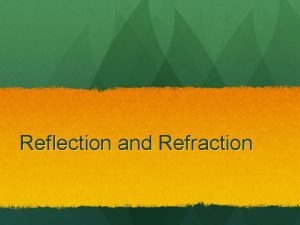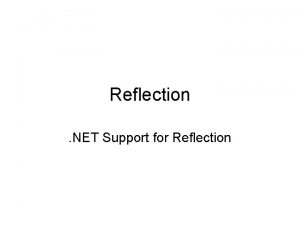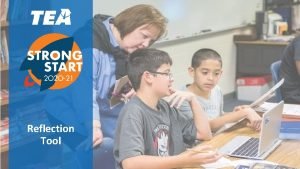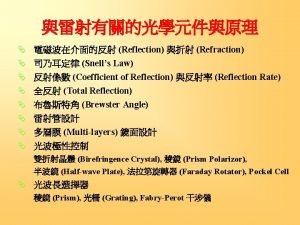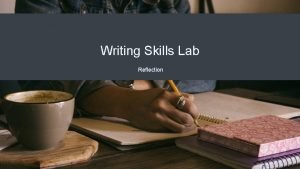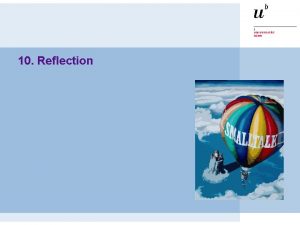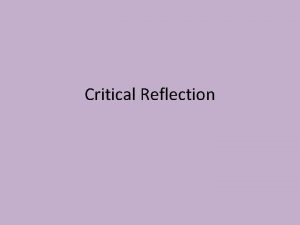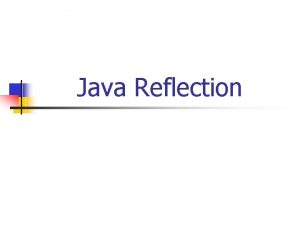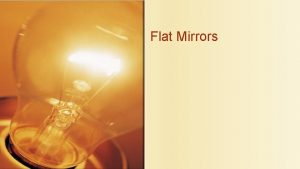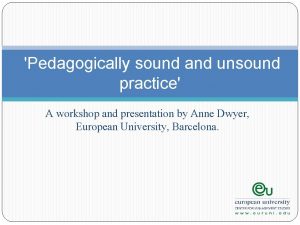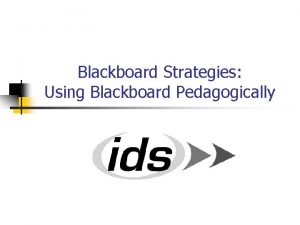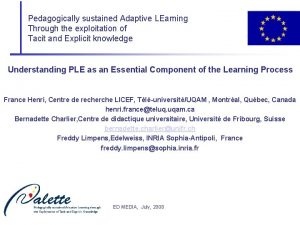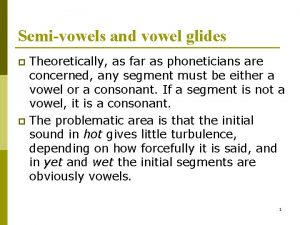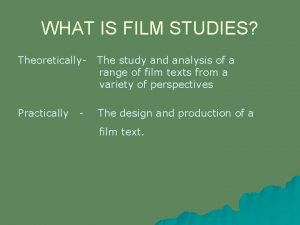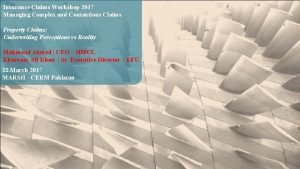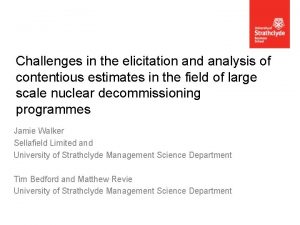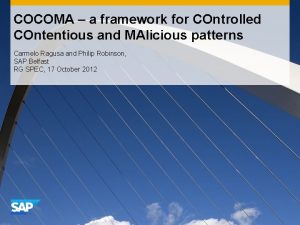Reflection is a pedagogically and theoretically contentious concept






























- Slides: 30

Reflection is a pedagogically and theoretically contentious concept in Higher Education. It incorporates multiple approaches that are open to interpretation and quite context specific. That said one thing most will agree upon is that it is a necessary part of quality practices in Higher Education which should happen at multiple points in the learning and teaching cycle (developing outcomes, constructing Unit of Study outlines, choosing learning and teaching methods, assessment, and evaluation). In this very brief introduction we have drawn out some starting concepts and ideas for your benefit, as well as a list of useful references.

All manner of formal and informal occasions that are often quite complex (for example: lectures, field trips, laboratories, practicum placement, tutorial, participation in an assessment task, group work, unplanned occurrences, responses to student or staff comments, world events, personal or internal feelings). For the teacher and student these responses will include what they think, feel, do and conclude both at the time and/or after the experience.

Kind of critical reflection which is more cognisant of the various socio-cultural factors and subjectivities which impinge upon teachers and students. The practice of reflection as viewed as ideologically transformative.

Becoming a critically reflective teacher Recognizing and appreciating difference and diversity from a number of angles (for example race, ethnicity, gender, class, culture, religion, disability, age) and how these factors impact on learning and teaching • challenging and dealing with the taken for granted assumptions about teaching, learners, and the learning environment • identifying and negotiating how power operates in an always contested learning and teaching context • nurturing, facilitating and enabling a learning and teaching environment which challenges students to think critically and morally about a variety of issues • initiating socially engaged lifelong and transformative learning

Reflective practice is more than thinking about the nuts and bolts of teaching, it involves evaluating the processes of teaching and learning, and questioning why we do something rather than how. Importantly it involves learning from this process and initiating change when and where required. This is an iterative process with infinitely connected lines and loops "good teachers are always evaluating themselves

Critically reflective teachers are always thinking about how they influence and effect the learning and teaching environment, and importantly upon the likely effects of their teaching and presence upon the quality of their students' learning. A critically reflective educator will ‘frame’ their reflections from a student perspective and will embark upon a deliberate process of gathering information and evidence, and finding out how students’ are experiencing learning and teaching. Both evaluation and reflection are more productive when reinforced by evidence.

Appreciate how students perceive our intentions as teachers and assessors • understand the institution's intentions towards us in terms of evaluation • design and use methods of assessment that will contribute to deeper student learning • choose evaluation methods which contribute to the development and improvement of learning and teaching

consider your own ideas, beliefs, and values about reflection, as well as your current level of reflective skills and abilities • avoid assuming that everyone knows what reflection is or how to do it • research, gather information, appreciate and understand the diverse definitions, purposes, practices, processes and desired outcomes of reflection in the learning and teaching contexts (for both teachers and learners, and others such as employers, peers, managers) • develop a clear picture of how reflection can enable you to continuously monitor and evaluate your teaching, and your learning and teaching environment •

• commit to an ongoing and strategic process of personal and professional reflection, and do it! (use formal and informal methods) • clearly explain the what, why and how of reflection to students • facilitate teaching and classroom procedures and practices which allow students to learn how to develop skills in order to become reflective (practice, practice!) • regularly reflect upon your own work, teaching styles and methods, assumptions about students, the learning process (and the like) • reflect upon and evaluate the effectiveness of your reflection and evaluation schedules, methods, and purposes

The reflective teacher develops many questions to choose from to serve as objects of reflection. Such as … • What is it about my work and the learning and teaching context that I want to know about? • How do I find out about these things? • Who will I ask about these things?

Writing Collaborative journaling Diary Personal journals Narrative Biography Autobiography Creative writing Discourse analysis Reflective writing (free, independent, open ended, focussed, supported) Portfolio Action research Questionnaire Talking Role simulations Debates Discussion (understandings and practices) Self (student/teacher) Auto-ethnography Self assessment, Self reflection Reflecting aloud Self disclosure, confession Making time to reflect

Peer/work Peer coaching/mentoring Peer observation and feedback Work based learning Systematic observation Reading Student-created case studies Stimulated recall using video and audiotape Other Artifact collection Action learning Metaphor use Questioning Practical inquiry Critical incident analysis Developing higher order skills Teacher directed/led Guided reflection Values clarification Problem solving Childhood memory work Reflection through spirituality Encouraging voice Read- Reflection. pdf

The role of reflection in education has created an upsurge of interest amongst educators and researchers since Dewey’s (1991) ground-breaking work, which emphasized the positive roles that reflection might play in fostering students’ self-reflection, critical thinking, and in the demonstrable development of professional values or skills

Mann et al. (2009), they suggest that Dewey’s definition of reflection shares similarities with our understanding of critical thinking. Boud et al. (1985) aptly define reflection in the context of learning and focus more on one’s personal experience as the object of reflection, as referring to “those intellectual and affective activities that individuals engage into explore their experience, which leads to new understanding and appreciations” advocacy to improve student learning. In the present study, selfreflection is influenced by these interpretations

Problem-based learning (PBL) tend to be characterized by students working collaboratively in small groups, with learning centred on problems relevant to the students’ domain of study and much time spent on self-directed learning. In PBL, students learn by solving problems and reflecting on their experiences (Hmelo-Silver 2004). Reflecting on the relationship between problem solving and learning is a critical component of PBL and is needed to support the construction of extensive and flexible knowledge (Salomon and Perkins 1989).

Self-reflection helps students to (a) review the group process and their own personal functioning in the group, (b) understand how their learning and problem-solving strategies might be reapplied, and (c) relate new knowledge to prior understanding (i. e. contents that were discussed and taught). PBL incorporates reflection several times throughout the learning process and when completing a problem. At the completion of a problem, students reflect on what they have learned, how well they collaborated with the group, and how effectively they directed their learning. As such, students learn self-reflection when they become proficient in assessing their own progression in learning.

Reflection journal writing is believed to enable students to critically review processes of their own learning and behaviours, and to understand their ability to transform their own learning strategies (Gleaves et al. 2008). Reflection journals are variously referred to as “reflective journals” (e. g. Chirema 2007), “reflective learning journals” (e. g. Thorpe 2004) or “learning journals” (e. g. Moon 1999). The purposes of reflection journal writing include: to critically review the behaviours (e. g. strengths and weaknesses; learning styles and strategies) (Weinstein and Mayer 1986); learning of self and others; setting or tracking learning goals (i. e. how learning took place) (Lew and Schmidt 2011); and exploring connections between knowledge that was learned and students’ own ideas about them

Through reflecting and writing about new information or ideas, learners can better understand remember them. In addition, the articulation of connections between new information, ideas, prior or existing knowledge also deepens learning (O’Rourke 1998). Students in the experimental group used more cognitive strategies during a learning task as compared to those in the control group. Students who kept learning journals also showed more sophisticated conceptions of learning, greater awareness of cognitive strategies, and demonstrated the construction of more complex and related knowledge structures when learning from text. They also performed significantly better on the final examination for the course.

While reflection journals did not necessarily assist students with earning high grades on achievement tests, they did assist students in developing abstract thinking thereby enabling them to better conceptualize the meaning of technical definitions. Students appeared to develop better strategies in problem solving through writing as compared to mere memorizing of calculations. In addition, students also showed improvements in their reflective writing skills, for instance, they were able to develop personal conceptual definitions that were more understandable than technical definitions of the texts. Read-Self-reflection and academic performance. doc

Benefits of critical reflection Research has shown how deliberate and critical reflection on teaching practices contributes to excellence in teaching, and improved educational outcomes for all students. Critically reflective teaching practices encourage teachers to: · regularly evaluate their approaches to teaching and learning · understand more about the positive impacts of high-quality effective pedagogies on student’s learning

· become more aware of the importance of high-quality interactions, including strategic intervention and substantive conversations to maximise children’s learning · use action research approaches — e. g. drawing on alternative teaching strategies to help students to learn when familiar methods fail · co-construct learning with students.

Critical reflection involves analysing your own learning and teaching practices that may contribute to effective pedagogies within key components of an effective curriculum. These key components are: · understanding students · building partnerships · establishing flexible learning environments · creating contexts for learning · exploring what students learn.







1. Effective teachers draw out and work with the pre-existing understandings that their students bring with them. 2. Effective teachers teach some subject matter in depth, providing many examples in which the same concept is at work and providing a firm foundation of factual knowledge. 3. Effective teachers focus on the teaching of metacognitive skills, integrating those skills into the curriculum in a variety of subject areas.

Going deeper into the process of self-assessment Reflect on the different ways you have undertaken selfassessment in your service: Who was involved? Why? What was the purpose? What strengths did you identify from your assessment and reflection? What quality areas did you identify that needed to improve? What strategies or actions did you plan and/or implement to address the areas for improvement?
 The crucible act 2 vocabulary
The crucible act 2 vocabulary Level e unit 10
Level e unit 10 Attributuion
Attributuion Diffuse reflection vs regular reflection
Diffuse reflection vs regular reflection Compare and contrast your actual self and ideal self
Compare and contrast your actual self and ideal self Perbedaan pemasaran dan penjualan
Perbedaan pemasaran dan penjualan Reflection journal example
Reflection journal example What is total internal reflection
What is total internal reflection Chapter 29 reflection and refraction
Chapter 29 reflection and refraction Refraction of sound
Refraction of sound Chapter 17 reflection and mirrors
Chapter 17 reflection and mirrors Ppst domain 2
Ppst domain 2 Personal growth and professional development domain
Personal growth and professional development domain Community linkages and professional engagement clipart
Community linkages and professional engagement clipart Hrinfo dadeschools net dpgt
Hrinfo dadeschools net dpgt Colour wheel light
Colour wheel light Shear transformation in computer graphics
Shear transformation in computer graphics Poem reflection
Poem reflection Disadvantages of skimming reading
Disadvantages of skimming reading Refraction examples
Refraction examples Critical angle
Critical angle Reflection refraction transmission and absorption of light
Reflection refraction transmission and absorption of light Domain 1
Domain 1 Infrared light is also known as bill nye
Infrared light is also known as bill nye Invictus ernest hemingway
Invictus ernest hemingway Introduction of light reflection and refraction
Introduction of light reflection and refraction What is inductive approach
What is inductive approach Competitiveness, strategy, and productivity
Competitiveness, strategy, and productivity Lifelong learning and critical self-reflection
Lifelong learning and critical self-reflection Mitosis and meiosis reflection
Mitosis and meiosis reflection Definition of reflection and basic properties
Definition of reflection and basic properties

